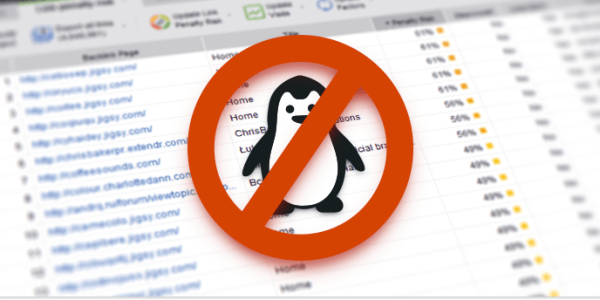As you probably know, lots of people are trying to remove bad links after the last Google algorithm update. Especially if we talk about links from private blog networks. You may want to do it as well. Chances are, that’s because you also got a warning message from Google in your Google Webmaster Tools account. In that case you need to make your next move really fast because it’s a manual action which means an actual live human being from Google checked your site and concluded that your link profile is not A-OK. Since you need to contact a whole lot of sites and ask to remove your links, it requires tons of time.
Hit by Penguin
In case you got no message from Google, but your rankings dropped like crazy after a Penguin update, you also need take the plunge and remove your bad links. All Penguin updates were all about low-quality links pointing to your site. And the last update is no exception.
Not Charged But Guilty
Alternatively, you may just feel or know that you have some noxious backlinks that you acquired (purchased or what not) back in the day. This situation is not that sucky as the previous ones because you act pretty much proactively before the disaster strikes.
In either case, you need to firstly pinpoint your bad links and then have them removed.
How to Find Bad Links
If you’re an experienced SEO guy and your site does not really have that much links, you may even want to do that manually. In case you have loads of links or you run a few online projects, that’s not really an option because you’d need to be finding your bad links round the clock. No fun at all. So, what now?

Link Detox it!
Thing is, you can just make use of the Link Detox tool from LinkResearchTools.com that allows to automatically find links that may be negatively impacting your site’s reputation in Google’s eyes. Once you get your report with the help of Link Detox, you’ll know what sites you need to contact in order to remove bad links. It’s a paid service, but you’ll be able to complete your job by a long shot faster. And that, by far and large, means the world in most cases. That said, you still need to invest some time in double-checking whether the tool correctly marked certain links as bad ones. You need to pay special attention if it’s a controversially bad link. That’s because nothing is ideal in the world. Neither is Link Detox.
Having generated your list of sites that have negative links pointing to your site, you MUST contact them asap because Google requires that you do whatever it takes to have your links removed without disavowing. And only if that does not work, you should make use of the Disavow tool that Google released not that long ago. By the way, here’s how you can use the Disavow tool right from Matt Cutts.
How to Contact
As a rule of thumb, you need about a week or two to contact those site owners in every possible way. You want to contact them via the contact form on the site, email address, Twitter or Facebook account, etc. Also, it’s a good idea to follow up and remind them about it in 3-4 days just in case your message somehow got in the spam folder or they did not notice if for some other reason.
Who.is it
By the way, if you got no reply after sending an email to the email address that you found on the site, you should try Who.is to find that site’s alternataive contact email, though it usually did not work in my case. Thing is, it’s possible to hide (protect) your contact information for an extra fee that you need to pay to your hosting provider. Hopefully, your site owners had no idea about that option and you can easily find their contact details via Who.is. 🙂
Jot it Down
Note that you need to document all you did so that you can provide that proof in your Disavow tool when you submit the file to Google. I’m not exactly sure how exactly (if at all) Google knows that you actually did what you state in your Disavow file comments. The first thing that springs to mind is that they may be monitoring your gmail account, but what if you use a different email provider? Though it still remains a mystery how they double-check your provided evidence of contacting site onwers for link removals, you really need to do it as Google asks. That just goes to show that you kindly did what Google asked you to rather than trying to game the system.
Tip
As a rule of thumb, it’s a good idea to create a Google spreadsheet and color mark the sites you already contacted, how exactly (email, Facebook, Twitter, etc) and when you did it. It’ll allow you to keep things nice and neat. That’ll greatly contribute to your peace of mind during that sort of menial and non-fun SEO activity. You’ll just easily see at a glance what you’ve already done and what you still need to get your hands dirty with.
It goes without saying that it’s up to you how to put together your email message, but here’s what worked for me:
Hey there,
I’m , SEO from
It’s been detected that our link from your site negatively influences our site’s SEO metrics.
The link is on this page:
The anchor text is:
And the destination URL is:
I kindly ask you to remove the link asap.
Please let me know if you have any questions or need assistance with removing the link.
Best regards,
Procrastination Aspect
If you have a really huge backlink profile, you’ll need to spend at least a few days on contacting those sites for removing bad links. I betcha try to procrastinate. It’s just the nature of the beast. You may want to listen to an audiobook from Audible.com or just enjoy your favorite podcast. Alternatively, why not listen to some music that really makes you tick. Like Reggeaton or something. In case you need a more in-depth remedy against procrastination, use this $30 promo code link to take the Productivity Strategies to Destroy Your Inner Procrastinator video course.
Useful Links
8 Steps to a Penguin-Proof Link Audit
What it Boils Down to
You need to pinpoint the bad links that you need to remove, do whatever is possible to have the links removed and, if everything else fails, just apply the Disavow tool from Google. Again, be sure to double-check all the links that are not that obviously bad ones. If you remove good links, you’ll shoot yourself in the foot. Bad links search is not gonna be fun, but you just need to get the job done.
In case you’ve already did your job with removing bad links, would you mind sharing what worked for you and what kind of issues you’d recommend to stay away from?





